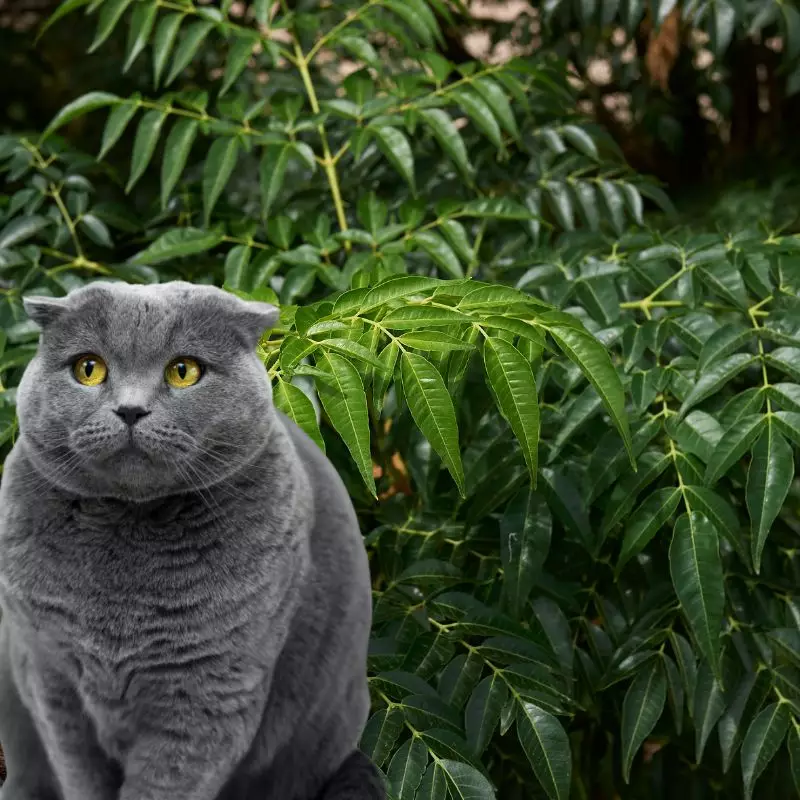Bead Trees, often referred to as Chinaberry Trees, are prevalent in public spaces and gardens due to their ornamental value. However, households with cats should exercise caution, as the Bead Tree contains harmful substances, namely meliatoxins, that are poisonous to felines, warranting immediate concern and response.
This article is composed in partnership with a team of seasoned Doctors of Veterinary Medicine (DVMs), whose invaluable inputs enable the delivery of precise and current information on the potential hazards associated with various plants, the Bead Tree in this instance, and their impacts on cats. Additionally, extensive research has been conducted, referencing high-authority websites such as the ASPCA and PetMD, to ensure the accuracy and reliability of the information on every plant discussed.
The fruit of the Bead Tree is particularly toxic, although meliatoxins are present in the bark, leaves, and flowers as well. These neurotoxins target the nerves, leading to loss of motor function and impairment of essential bodily processes. They hinder neurons in the nervous system from transmitting impulses effectively throughout the body, resulting in involuntary muscle movements and a loss of control over fundamental body functions, leading, subsequently, to vomiting, diarrhea, and heart attacks.
Clinical Signs of Bead Tree Poisoning in Cats

When cats come into contact, ingest, or even smell parts of the Bead Tree, they may exhibit several clinical signs due to the toxic components found in the tree. Here’s a comprehensive overview of the symptoms and the underlying causes due to the interaction with the Bead Tree:
- Weakness: Cats may experience pronounced lethargy and weakness due to the meliatoxins affecting the nervous system and impairing muscular function, hindering their normal activities.
- Vomiting: The ingestion of any part of the Bead Tree induces nausea, causing cats to vomit as their bodies try to expel the toxic substances.
- Hypersalivation: Contact with meliatoxins leads to excessive salivation, as the body’s reflexive response to counteract the poison.
- Diarrhea: The gastrointestinal system is disrupted due to the toxic elements, resulting in frequent, loose stools.
- Bloody Stool: The severe irritation and damage to the gastrointestinal tract can lead to the presence of blood in the stools.
- Seizures: The neurotoxic effect of meliatoxins interferes with the normal electrical activity of the brain, leading to sporadic, uncontrollable muscle contractions or seizures.
- Loss of Consciousness: Severe poisoning can disrupt neurological functions to the extent of causing a loss of consciousness due to the inadequate supply of oxygen to the brain.
- Cardiac Arrest: The impact of the toxins on the body’s vital functions may culminate in the sudden cessation of heart activity, a life-threatening condition requiring immediate intervention.
Should you observe any of these signs of poisoning in your cat, it is imperative to seek immediate veterinary attention. Swift and appropriate veterinary care is crucial to counteract the effects of the toxins and to stabilize the cat’s condition.
First Aid and Treatment of Bead Tree Poisoning in Cats

There is no direct treatment for meliatoxin poisoning, but it can be neutralized with the help of a veterinarian. The first is to pump the cat’s stomach; although the vomiting and diarrhea will have emptied much of the digestive tract, trace amounts of bead tree material may still be present for the body to absorb. An IV drip will be started by the veterinarian to begin fluid replacement therapy. This will both prevent dehydration and dilute any toxins still present in the body.
Recovery from Bead Tree Poisoning in Cats

In most cases, symptoms of Bead Tree poisoning are only mild so you can take your cat home on the same day after treatment. If your cat’s condition is severe, the veterinarian may recommend hospitalization to closely monitor your cat’s condition. In order for your cat to regain a complete range of motor function, the vet may require follow-up appointments and potentially undergo physiotherapy sessions.
The recovery timeframe of your cat varies depending on the severity of the poisoning; some cats recover completely in a couple of weeks, while others remain disabled for the remainder of their lives.
Prevention of Bead Tree Poisoning in Cats
It is imperative to remove Bead Trees in the vicinity of your home if you have them. Keep your cat safe indoors and do not let them go outdoors without supervision. Maintain their good health condition by providing them sufficient and well-balanced diet.
If you love plants but have cats at home, check out these lists:





